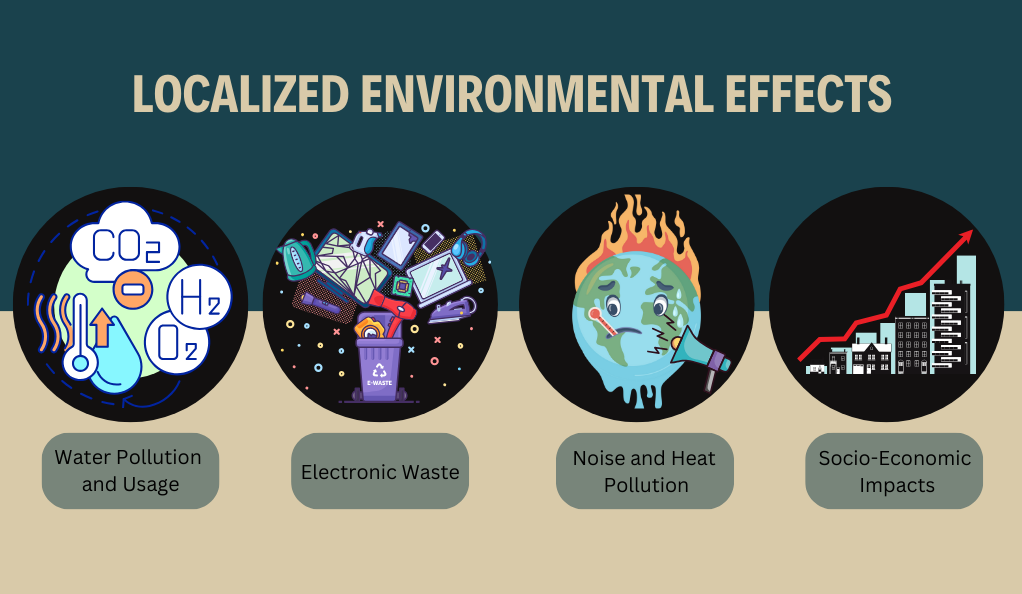In the digital age, cryptocurrency has emerged as a revolutionary form of decentralized finance, promising a future where transactions are secure, transparent, and free from traditional banking constraints. At the heart of this digital financial ecosystem is the process of cryptocurrency mining—a method by which transactions are verified and added to the public ledger, known as the blockchain. However, as the popularity and adoption of cryptocurrencies like Bitcoin and Ethereum have soared, so too have concerns about their environmental impact. This section delves into the intricacies of cryptocurrency mining and sets the stage for a deeper exploration of its environmental footprint.
What is Cryptocurrency Mining?
Cryptocurrency mining is the computational process by which new coins are introduced into circulation and transactions are added to the blockchain. Miners use powerful computers to solve complex mathematical problems; when solved, a new block is added to the blockchain, and the miner is rewarded with a certain number of coins. This reward serves two purposes: it issues new cryptocurrency tokens and incentivizes individuals to spend computational resources to keep the network secure.
The Rise of Cryptocurrency and Its Environmental Concerns
Since the inception of Bitcoin in 2009, the world of cryptocurrency has expanded exponentially. With over 10,000 different cryptocurrencies in existence today, the cumulative market capitalization has surpassed trillions of dollars. This meteoric rise has led to an increase in the number of miners and, consequently, a surge in energy consumption.
A study by the Cambridge Centre for Alternative Finance estimated that Bitcoin mining alone consumes more electricity annually than entire countries like Argentina or the Netherlands. Such staggering figures have ignited debates among policymakers, environmentalists, and industry stakeholders about the sustainability of cryptocurrency mining.
Setting the Stage for a Deeper Dive
Understanding the environmental impact of cryptocurrency mining is crucial, not just for the planet but also for the future viability of the crypto industry itself. As regulatory scrutiny intensifies and the global community becomes more environmentally conscious, the crypto industry must address these concerns head-on. This article aims to shed light on the environmental consequences of cryptocurrency mining, offering insights, data, and potential solutions to one of the most pressing challenges in the digital finance realm.
Estimated Annual Electricity Consumption of Bitcoin Mining
| Country/Entity | Annual Electricity Consumption (TWh) |
|---|---|
| Bitcoin Mining | 129 TWh |
| Argentina | 125 TWh |
| Netherlands | 108 TWh |
As we venture further into this exploration, it’s essential to approach the topic with an open mind, recognizing both the transformative potential of cryptocurrencies and the imperative to ensure their sustainable growth.
The Mechanics of Cryptocurrency Mining

Cryptocurrency mining, often visualized as the act of “digging” for digital gold, is a complex interplay of technology, mathematics, and energy. But what exactly happens behind the scenes? Let’s demystify the mechanics of this process.
Understanding Consensus Mechanisms
At its core, cryptocurrency operates on a decentralized network of computers. For transactions to be verified and recorded on the blockchain, these computers must agree or reach a “consensus.” This is where consensus mechanisms come into play. They are protocols that ensure all participants in the network agree on the validity of transactions.
The most prevalent consensus mechanism is Proof of Work (PoW). In PoW, miners compete to solve cryptographic puzzles. The first to solve the puzzle gets the right to add a new block to the blockchain and is rewarded with cryptocurrency. This mechanism, while secure, is energy-intensive, as it requires significant computational power.
The Role of Mining Hardware
The efficiency and speed of mining largely depend on the hardware used. In the early days of Bitcoin, standard CPUs (Central Processing Units) were sufficient. However, as the puzzles became more complex, more powerful hardware like GPUs (Graphics Processing Units) and specialized ASICs (Application-Specific Integrated Circuits) became the norm. These machines, designed exclusively for mining tasks, consume vast amounts of electricity, further intensifying the environmental concerns.
Mining Pools: Collective Effort for Greater Rewards
Given the increasing difficulty of mining puzzles, individual miners often find it challenging to mine a block and receive rewards. This led to the formation of “mining pools,” where miners combine their computational power to increase their chances of adding a block to the blockchain. While this collective effort boosts efficiency, it also means more machines are running simultaneously, leading to even higher energy consumption.
Energy Consumption: The Heart of the Issue
The allure of cryptocurrency, with its promise of decentralization and financial freedom, has been somewhat overshadowed by the growing concerns surrounding its energy consumption. As the crypto industry burgeons, it’s imperative to understand the scale and implications of its energy use.
Quantifying the Energy Appetite
Cryptocurrency mining, particularly Bitcoin, is notoriously energy-hungry. The PoW consensus mechanism, which underpins Bitcoin and several other cryptocurrencies, necessitates vast computational efforts. These efforts translate to high electricity consumption. To put it in perspective, the Bitcoin network’s annual energy consumption rivals that of countries like Ukraine or Belgium.
The Carbon Footprint Conundrum
It’s not just the sheer volume of energy consumption that’s concerning; it’s also the source of this energy. Many mining operations, especially in regions where electricity is cheap, rely on coal-fired power plants. These plants emit significant amounts of carbon dioxide, exacerbating the greenhouse effect and contributing to global warming. Consequently, the carbon footprint of a single Bitcoin transaction could be equivalent to thousands of VISA card transactions.
Localized Energy Strains
Regions that have become hubs for cryptocurrency mining, such as parts of China, Inner Mongolia, and even the Pacific Northwest in the U.S., have experienced localized strains on their power grids. These strains can lead to blackouts, increased electricity costs for residents, and additional wear and tear on infrastructure.
The Dichotomy of Renewable Energy
While it’s true that some mining operations use renewable energy sources, the overall percentage remains low. The intermittent nature of renewables like solar and wind means that miners often need to rely on non-renewable backups to maintain continuous operations. However, there’s a silver lining: the crypto industry’s demand for energy has spurred investments in renewable energy projects in some regions.
Carbon Footprint of Cryptocurrency Mining
As the digital tendrils of cryptocurrency extend further into the global economy, its environmental shadow grows more pronounced. Beyond the staggering energy consumption lies another pressing concern: the carbon emissions associated with cryptocurrency mining.
The Carbon Equation
Every kilowatt-hour (kWh) of electricity consumed has an associated carbon footprint, which varies based on the energy source. Fossil fuels, especially coal, have a significantly higher carbon footprint compared to renewable sources. Given that a substantial portion of cryptocurrency mining relies on fossil fuels, the resultant carbon emissions are alarmingly high.
Carbon Emissions per Energy Source
| Energy Source | Emissions (kg CO2 per kWh) |
|---|---|
| Coal | 0.94 |
| Natural Gas | 0.55 |
| Hydro | 0.005 |
| Solar | 0.02 |
| Wind | 0.015 |
Bitcoin’s Carbon Footprint
Bitcoin, being the most popular and valuable cryptocurrency, naturally draws the most attention regarding its environmental impact. Recent studies suggest that the carbon emissions from Bitcoin mining alone are comparable to the annual emissions of entire countries like Jordan or Sri Lanka.
Implications for Climate Change
The global urgency to combat climate change has never been higher. With international accords like the Paris Agreement setting stringent targets for carbon reduction, industries worldwide are under pressure to reduce their carbon footprints. The cryptocurrency industry, given its current trajectory, seems to be moving in the opposite direction. The carbon emissions from cryptocurrency mining exacerbate global warming, contributing to rising sea levels, extreme weather events, and biodiversity loss.
The Social Cost of Carbon
Beyond the environmental implications, there’s a social cost to the carbon emissions from cryptocurrency mining. This cost encompasses the economic damages resulting from a rise in global temperatures, affecting agriculture, human health, and infrastructure. Communities in vulnerable regions bear the brunt of these impacts, facing challenges like droughts, floods, and heatwaves.
Localized Environmental Effects

While the global implications of cryptocurrency mining are undeniably significant, it’s equally crucial to understand the localized environmental impacts. These effects, often overshadowed by the broader narrative, have tangible consequences for communities and ecosystems in mining-intensive regions.
- Water Pollution and Usage
Cryptocurrency mining requires not only electricity but also significant amounts of water, primarily for cooling the mining equipment. In areas where water is scarce, mining operations can strain local resources, leading to shortages. Moreover, improper disposal of waste heat can raise the temperature of local water sources, affecting aquatic life. - Electronic Waste
Mining hardware has a limited lifespan. As newer, more efficient models are developed, older equipment becomes obsolete. This rapid turnover results in significant amounts of electronic waste, which often contains hazardous materials like lead, cadmium, and mercury. When not properly recycled, these materials can leach into the soil and water, posing health risks to local communities. - Noise and Heat Pollution
Large-scale mining operations generate considerable noise, primarily from the cooling fans of the mining rigs. This constant hum can be a nuisance for nearby residents. Additionally, the heat produced by these operations, if not adequately managed, can contribute to localized warming, altering microclimates and affecting local flora and fauna. - Socio-Economic Impacts
The influx of mining operations in certain regions can lead to socio-economic challenges. While they might bring employment opportunities, they can also lead to increased living costs, particularly in housing and utilities. Moreover, the transient nature of some mining operations—shifting to regions with cheaper electricity or more favorable regulations—can leave local economies vulnerable when they depart.
The Landscape of Regulation
Recognizing these localized impacts, several regions have implemented or are considering regulations to manage and mitigate the adverse effects of cryptocurrency mining. These range from stricter environmental compliance standards to outright bans on mining activities.
The Shift Towards Sustainable Alternatives
The environmental challenges posed by cryptocurrency mining have not gone unnoticed by the industry. As concerns mount, there’s a growing momentum towards finding sustainable alternatives and solutions. This shift isn’t just about appeasing critics; it’s about ensuring the long-term viability of the cryptocurrency ecosystem.
Proof of Stake (PoS) and Beyond
One of the most discussed alternatives to the energy-intensive Proof of Work (PoW) consensus mechanism is Proof of Stake (PoS). In PoS, validators are chosen to create new blocks based on the number of coins they hold and are willing to “stake” or lock up as collateral, rather than on their ability to solve cryptographic puzzles. This method drastically reduces the energy required for the consensus process.
Ethereum, the second-largest cryptocurrency by market capitalization, is in the process of transitioning from PoW to PoS, a move that could significantly reduce its environmental footprint.
Beyond PoS, other consensus mechanisms like Delegated Proof of Stake (DPoS) and Proof of Authority (PoA) are also gaining traction. These methods further refine the consensus process to be more energy-efficient and equitable.
Green Mining Practices
As the name suggests, green mining initiatives prioritize sustainability. These can range from using renewable energy sources for mining operations to implementing practices that offset carbon footprints. Some mining farms are now located near hydroelectric power plants, while others invest in solar and wind energy infrastructure.
Carbon Capture and Offsetting
Recognizing the carbon emissions associated with their operations, some mining entities are investing in carbon capture technologies. These technologies trap and store CO2 emissions, preventing them from entering the atmosphere. Additionally, carbon offsetting—where miners invest in environmental projects to balance out their carbon footprints—is becoming a popular practice.
Recommendations for a Sustainable Crypto Future
The environmental challenges associated with cryptocurrency mining are undeniable, but they also present an opportunity. By addressing these issues head-on, the crypto industry can not only reduce its environmental impact but also enhance its credibility and long-term viability. Here are some recommendations to guide the industry towards a more sustainable future.
- Embrace and Accelerate the Shift to PoS and Other Efficient Consensus Mechanisms
As discussed, Proof of Stake (PoS) and its variants offer a more energy-efficient alternative to the traditional Proof of Work (PoW) mechanism. Cryptocurrencies, especially major ones like Ethereum, should expedite their transition to these greener alternatives. - Invest in Renewable Energy
Mining operations should prioritize renewable energy sources. By setting up operations in regions with abundant renewable resources or investing in renewable energy infrastructure, miners can significantly reduce their carbon footprint. - Develop and Adopt Green Mining Standards
The industry should collaborate to develop a set of “green mining” standards. These could encompass energy consumption benchmarks, waste management protocols, and carbon offset guidelines. Adherence to these standards could be incentivized through tax breaks or other benefits. - Support Research and Innovation
The crypto industry should fund research into new technologies and practices that can further reduce its environmental impact. This includes not only advancements in consensus mechanisms but also innovations in cooling technologies, energy storage, and carbon capture. - Educate and Engage the Community
The global crypto community, with its millions of users, developers, and enthusiasts, is a powerful force. By educating the community about the environmental implications of crypto mining and engaging them in sustainability initiatives, the industry can amplify its impact. - Collaborate with Regulators and Policymakers
Instead of resisting regulatory efforts, the crypto industry should proactively engage with policymakers. By collaborating on regulations that prioritize sustainability without stifling innovation, the industry can ensure a win-win outcome. - Transparent Reporting and Accountability
Transparency is key to building trust. Mining operations should regularly disclose their energy consumption, carbon emissions, and sustainability initiatives. This not only enhances credibility but also allows for benchmarking and continuous improvement.
Conclusion
The rapid ascent of cryptocurrency, hailed for its promise of decentralization, has brought with it significant environmental challenges, particularly in energy consumption and carbon emissions. As the industry grapples with these concerns, it also witnesses a surge in innovations aimed at sustainability, from energy-efficient consensus mechanisms to green mining initiatives. The global crypto community, in collaboration with regulators and environmental experts, plays a pivotal role in this transition. As cryptocurrency continues to evolve, the collective efforts of all stakeholders will determine whether it can strike a balance between its revolutionary potential and its responsibility towards our planet.




